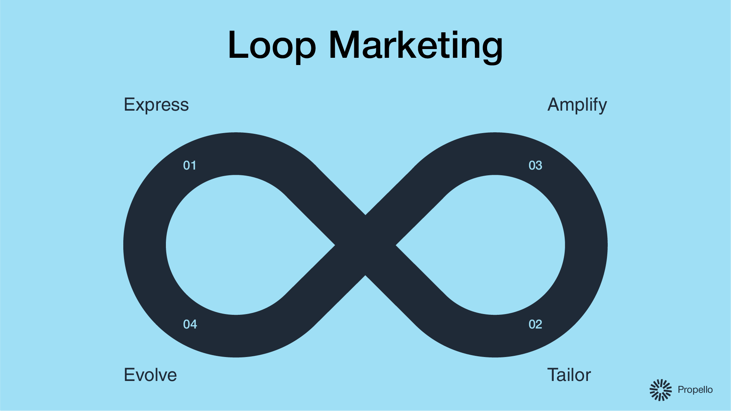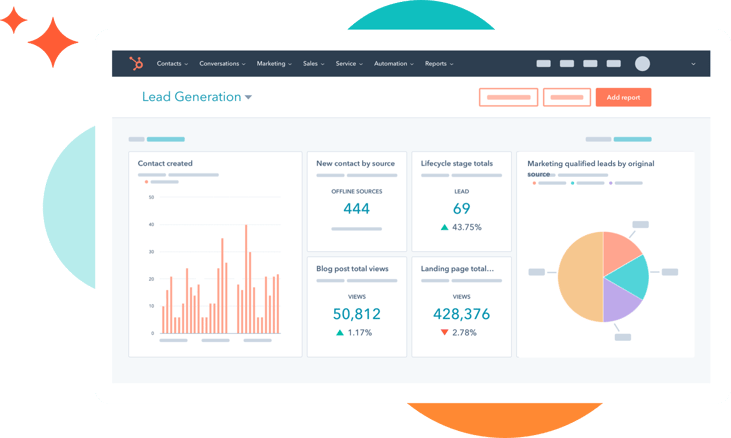Did you know that nearly 60% of Google searches end without a click? This shift signals a profound change in how prospects discover and engage with brands. Traditional marketing funnels, which once guided buyers linearly from awareness to purchase, no longer reflect the complexity of modern customer journeys.
Buyers now conduct around 80% of their research independently before contacting a salesperson, further emphasizing the need for marketing strategies that align with this behavior.
Loop marketing matters are especially relevant in the AI era, as they address the challenges of modern buyer behavior by leveraging ongoing, cyclical engagement and unified data to adapt to a landscape dominated by independent research and AI-driven search results.
Introduced to the market this year by HubSpot, Loop Marketing is a new four-stage approach that combines AI efficiency and human authenticity to drive growth.
So, how do you create marketing that not only reaches your audience but genuinely resonates and drives growth in this evolving landscape? What if your marketing strategy could continuously learn and adapt, becoming smarter with every customer interaction? This is where loop marketing comes into play, a framework designed for the AI era that blends human authenticity with AI-powered efficiency to create a continuous cycle of engagement and improvement.
Definition of Loop MarketingLoop marketing is a continuous cycle of customer interactions that combines human creativity with AI efficiency to improve marketing efforts. |
What is Loop marketing?
In simple terms, loop marketing replaces the traditional linear funnel with a dynamic, evolving system that adapts to how your customers actually behave today. By reimagining the entire customer journey as a continuous process, loop marketing enhances engagement, retention, and growth at every touchpoint.
It emphasizes creating personalized, relevant experiences across multiple channels and using unified data to refine your approach in real time. This framework is essential because it aligns your marketing strategy with the realities of buyer behavior, AI-powered search, and the demand for authentic engagement, including optimizing your content for AI search results to ensure greater visibility.
The Four Stages of Loop Marketing: Building a Continuous Growth Engine

Express Stage: Defining Your Brand Identity
At the heart of loop marketing lies the Express stage, where you define your brand's identity and voice. This foundation is crucial because it shapes every piece of content and interaction your audience experiences. AI tools can help you efficiently analyze customer reviews, social media comments, and other customer insights to craft a consistent brand voice that resonates across multiple platforms.
By paying attention to how customers describe your brand in their feedback, you gain valuable insights into how your brand's value is perceived and communicated. Express involves defining your brand's unique identity and core message, creating a brand style guide. When your brand stands clearly and authentically, you set yourself apart in a crowded market and build trust with your most valuable customers.
Establishing a strong brand stand ensures your business maintains relevance, visibility, and a competitive edge over time.
Tailor Stage: Creating Adaptive, Personalized Content
Once your brand identity is established, the Tailor stage focuses on making your marketing message feel personal and relevant to each customer. By creating adaptive content, you can dynamically personalize experiences in real time based on individual customer behavior and intent signals, leveraging AI and machine learning.
Leveraging AI-powered analysis of unified customer data (including CRM data, website behavior, and intent signals), you can segment your audience into meaningful groups or even treat each customer as a “segment of one.” Developing a unified customer profile enables you to deliver consistent and tailored marketing strategies across all touchpoints.
This customer-centric approach emphasizes creating content that is comprehensive, AI-optimized, and aligned with emerging personalization and discovery methods, thereby increasing engagement and shortening sales cycles.
For example, when you embed relevant videos on landing pages, you not only deepen trust but also provide contextual, valuable experiences tailored to individual customer needs, demonstrating that you understand your audience’s specific challenges.
Amplify Stage: Meeting Your Audience Where They Are
Your message is only as effective as its reach. To maximize impact, it is crucial first to understand your target audience and who you are trying to reach with your content. The Amplify stage ensures your tailored content is visible across multiple channels: social media, search engines, AI engines, and more.
Identifying the platforms where your ideal customers spend time lets you focus your efforts on the most effective channels for engagement. This requires strategic channel diversification, supported by robust content strategies that leverage audience segmentation and planning to amplify your message.
Optimizing content for Answer Engines requires structuring it for easy understanding and citation by AI-powered search engines. By repurposing blog posts into various formats, optimizing them for different platforms, and distributing them through marketing studio tools, you can increase your content’s reach and engagement.
Inbound marketing is a key approach within the amplification stage, helping attract high-quality leads and support business growth, ensuring you engage your audience wherever they spend their time.
Evolve Stage: Iterating Based on Real-Time Insights
The final stage, Evolve, is about continuous improvement. Using AI-powered tools to track engagement and conversion signals, you analyze customer behavior and campaign performance in real time. Advanced analytics are used to track performance across all channels, ensuring that every aspect of your strategy is measured and optimized.
AI can also generate content based on real-time insights, allowing you to quickly adapt messaging and creative assets to current trends and audience needs. This stage transforms your marketing into a learning engine that adapts quickly to changing customer preferences and market conditions.
By integrating insights from sales calls and customer interactions back into your marketing strategy, you refine and formalize your sales process, making it more efficient and effective. Optimization efforts can then be focused on high-value customers, ensuring that your resources are directed toward the most profitable segments.
This creates a feedback loop that sharpens your approach and drives sustained growth.
Why Loop Marketing Matters: Aligning Strategy with Modern Buyer Behavior
The days of pushing prospects down a fixed funnel are over. Buyers conduct extensive research independently, often using AI tools before ever engaging with your sales team. Loop marketing matters because it reflects this new reality, focusing on building trust and delivering value continuously.
The ultimate goal is to generate an endless stream of customers (a continuous flow of qualified prospects) by creating a scalable, authentic brand presence that earns ongoing trust. It leverages unified data to understand your most valuable customers deeply and uses AI to create personalized, authentic experiences at scale.
To build credibility, it's essential to demonstrate to prospects that you understand their needs through personalized content and relevant videos. This customer-centric approach is not just effective, it’s the only sustainable way to grow in today’s complex, AI-driven marketplace.
Building a Content Strategy That Fuels Your Loop
A successful loop marketing strategy requires a robust content foundation. Developing content around the core questions your customers ask (cost, problems, comparisons, reviews, and best-ofs) ensures you address their needs at every stage.
Use AI to analyze social media comments and customer reviews to identify these questions and create content that resonates. The Big 5 content framework fuels Loop Marketing by addressing critical buyer research topics.
Remember to optimize this content for AI visibility using AEO best practices to increase your chances of being surfaced in relevant queries.
Measuring and Optimizing Performance in Loop Marketing
In loop marketing, the journey doesn’t end once your message is out in the world—it’s just the beginning of a continuous cycle of learning and improvement. Measuring and optimizing performance is essential to ensure your marketing strategy remains effective and responsive to real customer needs.
In the AI era, businesses have access to powerful, AI-powered tools that can efficiently analyze customer reviews, track web behavior, and monitor engagement and conversion signals across multiple channels.
Leveraging Unified Data for Holistic Insights
By collecting and unifying data from every customer interaction (whether it’s a comment on social media, a click on your website, or feedback in a review), you gain a holistic view of how your audience responds to your marketing efforts. AI tools can sift through this wealth of information to identify patterns and trends that might otherwise go unnoticed.

For example, you might discover that certain types of content drive higher engagement among specific audience segments, or that particular web behaviors signal a readiness to buy. Insights from each campaign cycle should be documented to inform future strategies and enhance continuous improvement.
Real-Time Optimization and Rapid Experimentation
These insights allow you to make data-driven adjustments to your marketing strategy in real time. You can refine your messaging, adjust your content strategy, and optimize your campaigns to better align with what your customers actually want and need.
Conducting rapid experiments in short A/B tests enables continuous campaign refinement. This ongoing process of measurement and optimization keeps the loop marketing framework dynamic and effective, ensuring that each cycle brings you closer to your goals and delivers greater value to your customers.
Conclusion: Embrace the Loop for Continuous Growth and Trust
Loop marketing is more than just a framework; it represents a fundamental mindset shift essential for thriving in the AI era. By clearly expressing your unique brand identity, tailoring truly personalized experiences using unified customer data and AI-powered insights, amplifying your message across multiple channels, including AI engines and social platforms, and continuously evolving through real-time performance tracking and rapid experimentation, you build a self-reinforcing cycle of growth and trust.
In a world where nearly 60% of Google searches end without a click and buyers complete 80% of their research independently, traditional funnels no longer suffice. Loop marketing aligns your marketing strategy with these new behaviors by focusing on authentic engagement, AI engine optimization (AEO), and delivering relevant content where your audience actually spends time.
The question is no longer if you should adopt loop marketing, but how quickly you can start creating marketing that learns, adapts, and builds lasting trust at every touchpoint; fueling sustained growth and positioning your brand as a trusted authority in the modern digital landscape.
Ready to transform your marketing with Propello? As a proud HubSpot Partner Agency, we combine HubSpot’s powerful tools with our expertise to deliver personalized, engaging campaigns that drive growth and build lasting customer trust.
Get started today and experience the future of loop marketing. Schedule your free demo with Propello now!
Frequently Asked Questions (FAQ)
What is the main difference between loop marketing and traditional marketing funnels?
Loop marketing replaces the linear funnel with a continuous cycle that learns and adapts from every customer interaction, whereas traditional funnels follow a fixed, one-way path ending at purchase. This makes loop marketing better suited for today’s fragmented, AI-influenced buyer journeys.
How does AI contribute to loop marketing?
AI powers the analysis of unified customer data, identifies intent signals, and helps create personalized, adaptive content. It also enables real-time performance tracking and optimization, making your marketing more efficient and relevant.
Why is channel diversification important in loop marketing?
Because customers engage across multiple platforms—social media, search engines, AI assistants—diversifying channels ensures your message reaches your audience wherever they spend their time, increasing visibility and engagement.
How can I start implementing loop marketing in my business?
Begin by defining your brand identity clearly (Express stage), then use AI-powered tools to tailor personalized content (Tailor stage). Next, amplify your message across relevant channels, and finally, use real-time data to evolve and optimize your strategy continuously.
What role does unified customer data play in loop marketing?
Unified customer data consolidates information from multiple touchpoints, providing a comprehensive view of each customer. This enables more accurate segmentation, personalization, and measurement, which are essential for effective loop marketing.


